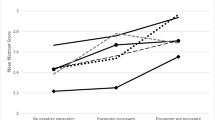Abstract
Although the health impact of patients’ trust in physicians has been well documented, less is known about the possible health effects of trust in police or paramedics. Homeless people frequently interact with police officers and paramedics, and these experiences may affect their health and future willingness to seek emergency assistance. We examined homeless people’s self-reported interactions with police and paramedics in Toronto, Canada, and their level of trust in these emergency service providers. In a sample of 160 shelter users, 61% had interacted with police in the last 12 months, and 37% had interacted with paramedics (P=.0001). The proportion of subjects who expressed willingness to call police in an emergency was significantly lower than those willing to call paramedics in an emergency (69% vs. 92%, P=.0001). On a Likert scale ranging from a minimum of 0 to a maximum of 5, trust levels were lower in police than in paramedics (median level 3 vs. 5, P=.0001). Among shelter users, 9% (95% confidence interval [CI], 5% to 14%) reported an assault by a police officer in the last year, and 0% (95% CI, 0% to 4%) reported an assault by a paramedic. These findings showed that homeless people have much lower levels of trust in police than paramedics. Reports of negative interactions with police are not uncommon, and homeless people’s perceptions of the police may pose a barrier to seeking emergency assistance. Further research is needed for objective characterization of homeless people’s interactions with police officers and the potential health implications of low levels of trust in the police.
Similar content being viewed by others
References
Stoutland SE. The multiple dimensions of trust in resident/police relations in Boston. J Res Crime Delinquency. 2001;38:226–256.
Fine M, Freudenberg N, Payne Y. “Anything can happen with police around”: Urban youth evaluate strategies of surveillance in public places. J Soc Issues. 2003;59:141–158.
Tyler TR. Public trust and confidence in legal authorities: what do majority and minority group members want from the law and legal institutions? Behav Sci Law. 2001;19: 215–235.
Hall MA, Dugan E, Zheng B, Misra AK. Trust in physicians and medical institutions: what is it, can it be measured, and does it matter? Milbank Q. 2001;79:613–639.
Balkrishnan R, Dugan E, Camacho FT, Hall MA. Trust and satisfaction with physicians, insurers, and the medical profession. Med Care. 2003;41:1058–1064.
Ahern MM, Hendryx MS. Social capital and trust in providers. Soc Sci Med. 2003; 57:1195–1203.
Boulware LE, Cooper LA, Ratner LE, LaVeist RT, Power NR. Race and trust in the health care system. Public Health Rep. 2003;118:358–365.
Davidson PJ, Ochoa KC, Hahn JA, Evans JL, Moss AR. Witnessing heroin-related overdoses: the experiences of young injectors in San Francisco. Addiction. 2002;97:1511–1516.
Darke S, Ross J, Hall W. Overdose among heroin users in Sydney, Australia: II. Responses to overdose. Addiction. 1996;91:413–417.
Hwang SW. Mortality among men using homeless shelters in Toronto, Ontario. JAMA. 2000;283:2152–2157.
Hwang SW. Homelessness and health. CMAJ. 2001;164;229–33.
Padgett DK, Struening EL, Andrews H, Pittman J. Predictors of emergency room use by homeless adults in New York City: the influence of predisposing, enabling and need factors. Soc Sci Med. 1995;41:547–556.
Goering P, Tolomiczenko G, Sheldon T, Boydell K, Wasylenki D. Characteristics of pe who are homeless for the first time. Psychiatr Serv 2002;53:1472–1474.
Gelberg L, Linn LS, Leake BD. Mental health, alcohol and drug use, and criminal history among homeless adults. Am J Psychiatry. 1988;145:191–196.
Fischer PJ. Criminal activity among the homeless: a study of arrests in Baltimore. Hosp Community Psychiatry. 1988;39:46–51.
Martell DA, Rosner R, Harmon RB. Base-rate estimates of criminal behavior by homeless mentally ill persons in New York City. Psychiatr Serv. 1995;46:596–601.
Desai RA, Lam J, Rosenheck RA. Childhood risk factors for criminal justice involvement in a sample of homeles people with serious mental illness. J Nerv Ment Dis. 2000; 188:324–332.
Tolomiczenko G, Goering P. Gender differences in legal involvement among homeless shelter users. Int J Law Psychiatry. 2001;24:583–593.
Benda BB, Rodell DE, Rodell L. Crime among homeless military veterans who abuse substances. Psychiatr Rehabil J. 2003;26:332–345.
Graser D. Panhandling for change in Canadian law. J Law Soc Policy. 2000;15:45–91.
Kalogerakis G. Cop’s trial starts in Lizotte death: vagrant’s beating in 1999 caused uproar. Montreal Gazette. April 29, 2002;sect A:A3.
Duncanson J, Welsh M. Eight Metro officers suspended as assault probed. Toronto Star. August 28, 1996;sect A:A1.
Pron N, Deverell J. Kerr claims victory in beating case. Toronto Star. January 25, 2003; sect A:A23.
DiManno R. Police payoff to Kerr speaks for itself. Toronto Star. January 25, 2003; sect A:A01.
Cooper M. Squeegee man gives account of shooting by police officer. New York Times. June 19, 1998;sect B:1.
Chen DW. Amtrak police officer indicted in assault case at Penn Station. New York Times. July 16, 1998;sect B;2.
Newton J. Shooting broke LAPD’s rules, inspector finds; report: police commission official’s conclusion about the death of a homeless women could intensify the conflict between Chief Bernard Parks and the civilian board. Los Angeles Times. February 12, 2000;sect A:1.
Castaneda R. One officer guilty, one acquitted in Prince George’s dog attack. Washington Post. August 16, 2001.sect A:A01.
Berry S. Ex-officers face jail in assault; LAPD: the two plead no contest in an attack on a homeless man. Critics say plea deal too lenient. Los Angeles Times. August 2, 2002;sect California Metro, part 2:4.
Kawachi I, Berkman LF. Social cohesion, social capital, and health. In: Berkman LF, Kawachi I, eds. Social Epidemiology. New York, NY: Oxford University Press; 2000. 174–190.
Crowe C, Hardill K. Nursing research and political change: the street health report. Can Nurse. 1993;89:21–24.
Homelessness: Programs and the People They Serve. Findings of the National Survey of Homeless Assistance Providers and Clients. Washington, DC: Interagency Council on the Homeless; 1999.
Author information
Authors and Affiliations
Corresponding author
Rights and permissions
About this article
Cite this article
Zakrison, T.L., Hamel, P.A. & Hwang, S.W. Homeless people’s trust and interactions with police and paramedics. J Urban Health 81, 596–605 (2004). https://doi.org/10.1093/jurban/jth143
Issue Date:
DOI: https://doi.org/10.1093/jurban/jth143




